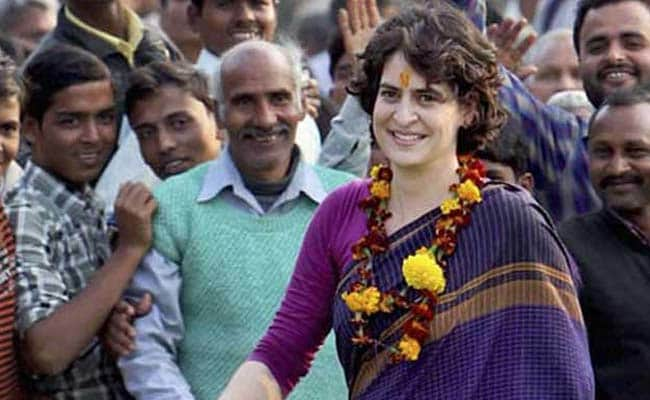Nyay May Not Counter Shakti, Priyanka Could

Election campaigns are gaining momentum, but the agenda for the 2019 general elections remains fluid. It was touted as “Modi vs The Rest”, but the hype died down as the Mahagathbandhan could not quite take off as envisaged, with the SP and BSP refusing to ally with the Congress in what is the largest of states.
The BJP has not yet gone big on the mandir issue. Charges of corruption and cries over lack of employment have been doused with periodic doses of nationalism. The charges of corruption in the Rafale deal flew away in the post-Pulwama air strike. The “Chowkidar Chor Hai” cry, too, got diluted when many leaders, workers and supporters of the ruling party joined the Prime Minister’s “Mein Bhi Chowkidar” campaign.
The latest to enter the ring was Rahul Gandhi’s Nyay scheme and Narendra Modi’s “Mission Shakti”. The Congress president made a desperate attempt to change the narrative by bringing up the minimum income guarantee scheme for the poor. Many thought the “Garibi Hatao” slogan chanted by his grandmother was back in the reckoning. But the very next day, the country saw a chest-thumping announcement by the Prime Minister, that India had successfully launched an anti-satellite missile, securing its safety in space.
Can Nyay compete with Mission Shakti? Probably not. Though elections should always be fought on the issues of roti, kapda and makaan, people get a chance to elect their representatives and government once in five years. They should apply their rational thinking power when exercising their voting right. Unfortunately, Indian elections are not always driven by rational choices, but by “cult-politics”.
Say, how many voters vote on the basis of personal qualities of the candidates in their constituency? How many of them vote on the basis of policies of the political party? How many of them consciously cast their vote considering corruption and criminal records of the politicians? Most of them either vote for the leader of the political party or just the symbol.
Through the ages, Indian political culture has been shaped by voters engaging in “hero-worship”. From Mahatma Gandhi to Pandit Jawaharlal Nehru to Indira Gandhi to Atal Bihari Vajpayee to Narendra Modi, people loved to put their leaders on the pedestal.
This is true about regional leaders as well. Starting from N.T. Rama Rao to M.G. Ramachandran, Jayalalithaa, Karunanidhi, Biju Patnaik, Jyoti Basu, Mayawati to Mamata Banerjee – all of them got to be cult figures among their supporters to retain their popularity and electoral success. Their sins were easily forgotten by the electorate and sycophancy replaced rational decisions.
This is true about the Gandhi family as well, as also the brand built around Narendra Modi. More than dynastic politics, the major challenge to Indian democracy is the tendency by the masses to hero-worship politicians. A leader may be popular for his leadership qualities, but the problem arises when the leader becomes a “God”.
Addressing the Constituent Assembly on November 25, 1949, Dr B.R. Ambedkar had said: “In India, Bhakti or what may be called the path of devotion or hero-worship, plays a part in its politics unequalled in magnitude by the part it plays in the politics of any other country in the world. Bhakti in religion may be a road to the salvation of the soul. But in politics, Bhakti or hero-worship is a sure road to degradation and to eventual dictatorship.”
The more the electorate is mesmerised by this cult politics, the more they lose the power to make rational choices. That is why people committed suicide when then Tamil Nadu Chief Minister M.G. Ramachandran died or supporters burnt themselves alive when M. Karunanidhi was arrested. This is why Mayawati, despite the number of corruption charges against her, remains a “godmother” to her supporters.
This is the same reason why despite being a bad orator, chief ministers like Navin Patnaik or N. Chandrababu Naidu win election after election. Or, despite being sentenced to jail for corruption, Lalu Prasad Yadav’s RJD still enjoys popularity.
The context of the 2014 and 2019 elections might be different, but the BJP is still relying on the “56-inch” narrative built around Narendra Modi, while Rahul Gandhi’s attempts to shed his “Pappu-image” have not succeeded completely so far.
Many have found hope in his sister Priyanka Gandhi, not because of her dynastic connection, but because of the possibility of building a cult-image around her. Many commentators have even found Indira Gandhi come alive in her face, attire and, sometimes, gesture. Initially, the appointment of the new Congress general secretary in charge of eastern Uttar Pradesh might have sent shock waves in political circles for its surprise factor, but it was a soft launch.
It is still not clear how the Congress party plans to make use of her capabilities. For this election, time is running out. Unfortunately, in Indian political culture, personalities matter over policies. Nyay cannot really fight Mission Shakti. A cult-image of Priyanka Gandhi could probably do the job.
Disclaimer: The views and opinions expressed in this article are those of the authors and do not necessarily reflect the official policy or position of the web portal.

Comments are closed.